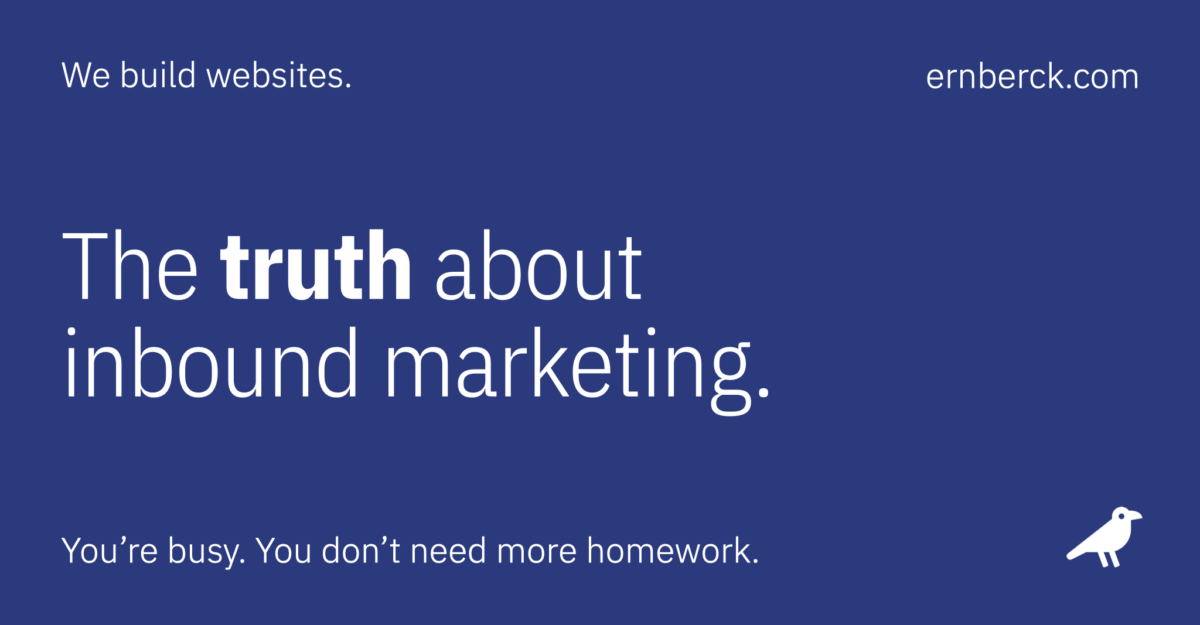Inbound marketing is often presented as the go-to strategy for building customer relationships. But inbound marketing on its own isn’t always enough. To be successful, businesses must first capture attention through outbound marketing.
Inbound vs outbound marketing
You may have heard these terms before and been thoroughly baffled by the confusing definitions you found online. Is it really that complicated? Not really. Marketing agencies just want you to think it’s some big mystery so they can charge you an arm and a leg for their advice. Not to worry, this article will help untangle the jargon. But, before going any further, let’s define a couple terms.
What is inbound marketing?
Inbound marketing is a technique for drawing customers to products and services via content marketing, social media marketing, search engine optimization (SEO), and branding. Customers magically “discover” your business online, seek you out, and come to you. That’s the inbound part. It’s sometimes called “permission” marketing.
What is outbound marketing?
No mystery here, it’s mostly advertising: TV, radio, Facebook ads, Google ads, magazines, newspapers, billboards, direct mail, cold calling, cold email, blimps, whatever. You pay to broadcast your message to potential customers. That’s the outbound part. It’s sometimes called “interruption” marketing.
Why is this important?
Because some marketing experts will try to convince you that inbound marketing is the only viable way to create a profitable long-term relationship with your customers. That may be true, but fans of inbound marketing often overlook how critical outbound marketing is to their success.
If you don’t reach out and get their attention first, people will never know you exist. And non-existence is a tough branding strategy in any economy.
The promise of inbound marketing
Current inbound marketing wisdom dictates that you consistently publish original long-form content that is irresistible to your target customers, who then seek out your wisdom with a desire to learn more. Supposedly, if you do that long enough, your customers will gladly buy whatever you’re selling. That’s the theory anyway. Does it work? For a few I suppose. For most, not so much.
Here’s a simple example of inbound marketing in action:

Seth Godin
“A tribe is a group of people connected to one another, connected to a leader, and connected to an idea. For millions of years, human beings have been part of one tribe or another. A group needs only two things to be a tribe: a shared interest and a way to communicate.”
What’s the catch?
This marketing strategy makes perfect sense, until you realize that its equation for success comes with a few snags. What happens if nobody sees your content, or you don’t have any social media buddies, or nobody on TikTok notices? What then?
If you don’t rank well in search engines — and nobody can find you — how do you get this whole process started?
Good question. Unfortunately, the likelihood of you producing original, authoritative content that is so good that it rises to the top of the search rankings is pretty slim. Chances are, nobody’s going to find your stuff. There’s already too much stuff out there.
What should you do?
So, how are you going to get noticed with this inbound marketing scheme? You probably won’t. Not unless you begin the process with some good old-fashioned outbound (interruption) marketing. Then, once you get the attention of some receptive customers, try a bit of inbound (permission) marketing.
In other words, you need to reach potential customers with a message designed to get them to raise their hand and say “yes.” Once they give you permission, you can begin a mutually beneficial exchange of information, which builds trust that you can leverage into a sales relationship.
Fortunately, there’s no shortage of outbound marketing channels that are suitable for interrupting people:
Digital advertising
- Google ads
- Pay per click (PPC) ads
- Social media ads
Traditional advertising
- Radio
- Television
- Out of home (OOH)
- Direct mail
Remember: The first step is to interrupt the customer. There will always be socially acceptable outbound marketing because you need to get that initial attention.
About Seth Godin
Seth Godin is an entrepreneur, best-selling author, speaker, and teacher. In addition to launching one of the most popular blogs in the world, he has written 18 best-selling books, including Permission Marketing, The Dip, Linchpin, Purple Cow, Tribes, and What To Do When It’s Your Turn.
The concept of outbound marketing was first described by Mr. Godin as “interruption marketing” back in 1999. He also coined the term “permission marketing,” a much more meaningful term than inbound marketing.
By focusing on everything from effective marketing and leadership, to the spread of ideas and changing everything, Seth has been able to motivate and inspire countless people around the world. In 2013, Seth was one of just three professionals inducted into the Direct Marketing Hall of Fame.
Summary
Inbound marketing has long been heralded as the modern, “permission-based” way to attract customers, but the reality is more complicated. For most businesses, inbound strategies alone won’t deliver the visibility or customer engagement they need.
The key is to combine the best of both worlds: use outbound marketing to first capture attention, and then follow up with inbound tactics to build trust and create long-term customer relationships.
Ultimately, the right balance of outbound and inbound marketing can lead to a more effective overall strategy that gets you noticed and helps you grow your business.
Sources
Related
Revised: October 6, 2024 at 11:41:55 AM PDT
